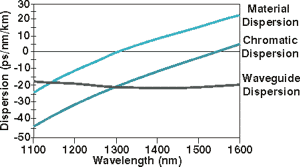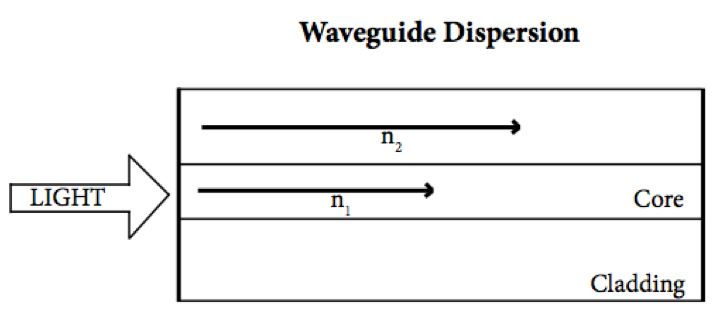Material dispersion is noted in the centre of the of the optical fiber (the core) due to its build. Optical fibers constitute glass fibers which are in turn materials that are formless.
Amorphous materials have no pattern or form in an atomic level. Two rays of light that share the same wavelength and transfer through the same path length can be conveyed in different areas of the core.
Due to this formless structure, these different areas will not bear 100% the same atomic level make-up as well as RI. Differences in rate are driven by atomic level differences in structure and likewise differences occur from differences between the compositions in the GL core. This type of dispersion is seen in both single mode as well as multimode fiber types.

Figure 1: Material, Chromatic and Waveguide dispersions per different wavelengths
Hint: Looking for differences between Single and Multimode fibers? You might be interested to read this.
Dispersion of the material leads to one out of three basic borders on bandwidth and conveyance distance. It is not possible to zero or cover material dispersion as in the case of modal and chromatic dispersion types.
WAVEGUIDE DISPERSION
The term “Waveguide dispersion” is the distribution of energy occurring from different speeds or RIs in the core and cladding regions of the fiber. It’s not possible to expel waveguide dispersion as in the case of modal and chromatic dispersion types.

Figure 2: Waveguide dispersion
POLARIZATION MODE DISPERSION
When the light is defined as an energy wave or energy region, it possesses 2 mutually perpendicular axes, the E (also known and electromotive force) and H, (also known as the magneto motive force).
The moment the energy inside these two axes transfers at different speeds in a fiber this leads to Polarization Mode Dispersion. PMD’s significance raises in levels that exceed 2.5 Gbps at long transmission distances.
Due to the fact that these rates and distances exceed much the level of data networks, PMD isn’t an issue in these types of networks. Still, PMD can be vital for telephone, CATC and networks of longer distance.
It’s not possible to zero or cover PMD as in the case of modal and chromatic dispersion types. Essentially, PMD is more significant in old fibers that were installed at least 15 years ago than newer optical fibers that were installed after 2000.
If you need read about Modal Dispersion and Chromatic Dispersion – we discuss in this article.


